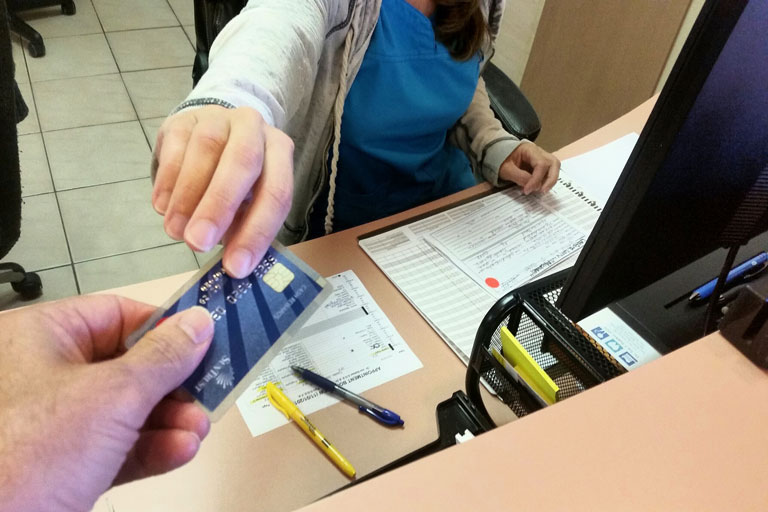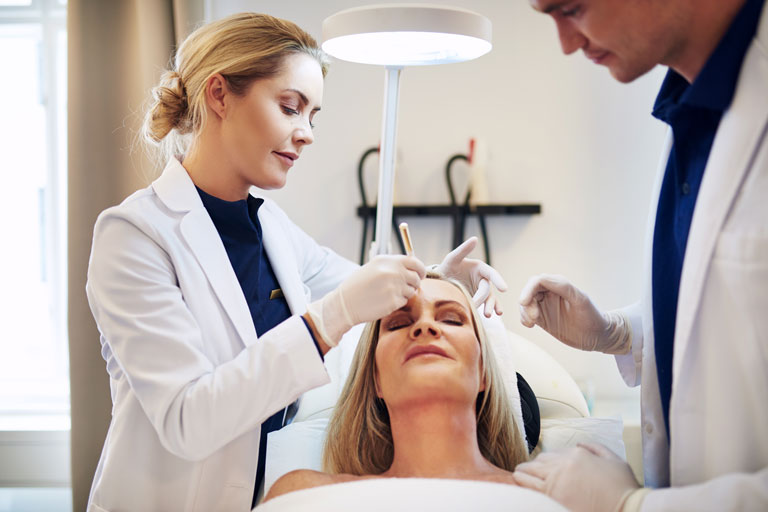Cosmetic surgeons need to accept credit card payments—or other financing options like a point-of-sale personal loan. Credit card processing for cosmetic surgery provides surgeons and patients with flexible, affordable, and secure payment solutions for copays after insurance, or when insurance won’t cover medically unnecessary procedures.
Cosmetic procedures are often outside the scope of what’s covered by medical insurance and patients who need or want cosmetic surgery typically have to pay out of pocket. With the average plastic surgery costing thousands, most patients can’t pay with cash. Most clients don’t carry that amount of cash on them, and though personal checks are another option, they are a hassle to deposit and could lead to bounced payments.
For all these reasons, debit and credit card payments are the best options for plastic surgeons, for hassle-free, streamlined, and secure payments.
Costs of Common Cosmetic Surgery Procedures
Breast augmentations costs an average of $6,525. A facelift may cost $12,250. Liposuction costs around $6,175. A Tummy Tuck can cost about $8,275. And a Rhinoplasty can average $7,650.
As you might guess, most of these procedures are purely for cosmetic appearances and not medically necessity. However, there are some instances when these procedures may have been medically necessary.
Cosmetic Surgeries That Are Covered By Insurance
The specific details of insurance coverage varies from company to company. If the surgery is elective, there’s a decent chance it will not be covered by medical insurance. However, if it is medically necessary, if there is an imminent, or preventative reason for performing the surgery, there is a greater likelihood that insurance will cover it. Insurance companies have a vested interest in keeping their long-term costs down, and covering preventative surgeries may be a cost effective solution.
Tonsillectomy
If, for example, removing tonsils will cost a few thousand dollars now, but prevent years of treating related medical conditions, the insurer will opt for a little cost now, over a lot of costs later.
Rhinoplasty
Rhinoplasties, or “nose jobs” are commonly performed exclusively for those who want to downgrade the size of their schnoz (if we may be blunt). But it’s also often performed for patients who have a mechanical issue like a deviated septum or small nostrils. These issues can obstruct airflow and lead to further complications, like difficulty breathing and sleeping—which in turn, can lead to a host of other physiological and even psychological complications.
However, insurance typically only covers the part of the procedure that will treat the symptoms, and not cover any reshaping or reduction. It’s up to each surgeon if they want to throw that in complementary, while the patient is under (if requested, of course), or if they will charge additional fees. Hence, where credit cards come in handy.
Blepharoplasty
Blepharoplasty is the removal of excess skin around the eyes, which can result from the weakening of muscles around them. If excess skin and fat are hanging down so low they cause visual obstruction, it becomes a safety and medical concern for which insurance companies will cover a corrective surgery.
Breast Reduction or Reconstruction
Breast reduction, reconstruction, or implant removal can also be covered by medical insurance. Especially, in patients with breast cancer who must have a mastectomy or a tumor removed. Insurance may cover the removal, but they may also help cover the costs of the reconstruction surgery, post cancer treatments. Additionally, if breast implants start to cause complications or infections, removal becomes necessary.
Skin Removal or Skin Graft
If a patient suffers from chronic rashes or epidermal infections, they may need skin removed. Burn victims, on the other hand may need skin grafts–not only for cosmetic reasons but because a healthy epidermis is a necessary part of keeping the internal body safe and retaining the moisture it needs to function. In these cases, insurance would cover these medically necessary procedures.

Insurance Doesn’t Cover Everything With Cosmetic Surgery
Keep in mind that medical insurance typically does not cover 100% of procedure costs. The patient will have to pay pay a portion of the procedure cost with their copay–especially, if the patient has not yet met their deductible.
American medical insurance is complicated. Especially after the introduction of the Affordable Care Act (which was touted as something that would simplify the insurance industry).
While plans, copays, and deductibles vary from patient to patient, the average deductible for employed individuals is close to $2,825. Some can go to $5,000 or more. That means they will have to shell out some money for procedures before their insurance company takes over.
If these high-deductible policyholders come to you for a nose job, breast implants, or skin graft, they are more than likely going to be paying for this surgery out of pocket because their deductible is so high. The only exception to this rule would be if the surgery is specifically covered in the Affordable Care Act (ACA) list of preventative care.
Spoiler alert: it’s not.
The ACA Does Not Mandate Coverage for Cosmetic Surgery
While these ACA preventive care measures include things like routine vaccinations, cancer screenings, and certain forms of counseling, it does not cover getting a schnoz resculpted—even if a primary care physician insists it is the root cause of his or her patient’s sleep apnea, which in turn is contributing to severe depression and irritability.
Of course, not every insurance plan has to be ACA-compliant; just those offered on public, government-sponsored marketplaces. For instance, around 13% of covered employers are covered by a non-ACA plan that was grandfathered in under the radar. These non-ACA plans may or may not cover some forms of plastic surgery if they are deemed a medical necessity. Either way, ACA-compliant plans are not required.
Cosmetic Surgery For Patients With No Insurance
And then, of course, there are those who just don’t have health insurance–nearly 30 million Americans after the mandate was repealed. Some of these individuals would like to have health insurance, but they haven’t secured employment that provides a healthcare benefit. Others are self-employed and reluctant to pay out of pocket. And some people (believe it or not) just don’t want health insurance because they think it’s a scam.
As you can see, there is much ink to be spilled on this topic, and if the whole topic confuses you and/or you don’t like the ACA, you’re not alone among polled plastic surgeons.
Regardless, patients without insurance have to pay for plastic surgery 100% out of pocket and those with insurance will still need to pay for plastic surgery, either because their insurance doesn’t cover it at all, or because they still have not met their deductible.
It’s likely they won’t pay for it with thousands of dollars in cash and it’s unlikely that you’d want to take on the risk of a personal check. A credit card processor is, therefore, the way to go for everybody.

How Do Patients Usually Pay for Cosmetic Surgery?
Medical Credit Card
One common way to pay for plastic surgery is with medical credit cards–such as CareCredit. CareCredit is not like a standard line of credit. Rather, CareCredit pays the medical provider (you) and then the patient completes a payment plan from 6 to 60 months.
However, there are some downsides to CareCredit-type arrangements, especially for the consumer. One is that CareCredit is all well and good if you can pay it off in time, never missing a payment. But if the borrower doesn’t pay it off in time, or misses a payment, these types of creditors can slap the cardholder with back interest, all at once.
Savings
Tapping into savings is another way that individuals can pay for plastic surgery. But with about 50% of Americans having less than $5,000 in savings, and 35% having less than $1,000, it won’t work for every patient.
Personal Loans & HELOCs
Patients can take out a loan to finance their cosmetic procedures. Personal loans, however, can have unfavorable terms such as high interest or a balloon payment structure, where the borrower must suddenly pay off a large amount of money by a certain date. A HELOC (home equity line of credit) will only work for patients who have excellent credit and have paid down enough of their mortgage to have at least 15% to 20% equity in their home. As for
Credit Cards
Credit cards are probably the most common way to pay for plastic surgery. And since many credit cards give points for purchases, it can, in a way, reduce their expenses. For example, a credit card with 1.5% cash back would result in a $60 statement credit on a $4000 surgery.
What’s often more relevant is the 0% APR that a new credit card might come with for a certain length of time, such as 12-21 months. A patient can put a plastic surgery charge onto such an account and carry the balance interest-free for almost two years—then open another account and use a balance transfer to bring the remaining balance onto the new credit card.
In fact, using a credit card might be the best way to pay for plastic surgery. There is no tapping into savings, no having to drain the checking account, and no punitive personal loans or CareCredit type of arrangements with the threat of back interest.
Can the Average Person Afford Cosmetic Surgery?
Around 55% of Americans have medical debt, largely because their health insurance has deductibles that they haven’t met. And what’s more, around 24% of these people cannot pay this debt off, resulting in overdue balances and long-term debt.
Much of this debt consists of emergency hospitalizations, doctor visits, lab fees, dental care, pregnancy and birth, ambulance services, and prescription drugs. With numbers like this, it’s hard to suggest that the average person can afford a large surprise like plastic surgery.
But then again, many plastic surgeries are not medically necessary surprises—they are purely discretionary cosmetic decisions made by people with disposable incomes or access to credit. And for those Americans who cannot afford it in terms of cash on hand, there is always more money to borrow.

How Does Credit Card Processing For Cosmetic Surgery Work?
Administrative tasks are one of the leading reasons for burnout in the medical profession. The good news, however, with taking credit card payments is that a payment processor takes so much of the backend work off your shoulders. All you need is a point-of-sale terminal and the software to manage it.
The information is sent over the card network (Visa, Mastercard, Discover, American Express) and worked out between their bank and your bank. For facilitating the payment, the payment processor will charge a small percentage per transaction.
Point-of-sale Financing for Cosmetic Surgery
Another unique payment solution to consider is point-of-sale financing. This payment method has become increasingly common in recent years as companies like Affirm, Afterpay, and Klarna help consumers navigate the retail landscape with payment plans. Sometimes they can even save money on a payment plan because the rates and fees are lower than they would be charged by a traditional creditor.
From your end, the lender will pay you for the procedure and the patient will be responsible for making payments to the lender. Everything can be packaged as if your office is presenting the plan at the point of sale for a streamlined patient experience.

Credit Cards are the Way to Pay For Cosmetic Surgery
Credit card processing for cosmetic surgery is a must for practitioners, as most patients will have to pay for all or a portion of their procedure. For those whose insurance policies do cover (some of) the procedure, there will still be copays and deductibles.
And for those who have not met their deductible or who are undergoing a completely elective procedure, credit cards are often the best option for making a manageable payment with the least punitive terms, and the easiest opportunity to roll the balance into a continued low-interest arrangement.
For these reasons, finding a good payment processor—e.g. one with the lowest rates, best and most responsive customer service, and best understanding of the medical profession—is the most important step you can take toward collecting patient payments.
To contact sales, click HERE. And to learn more about ECS Credit Card Processing for Cosmetic Surgery visit Healthcare.
